When looking for a phase effect pedal, we know what we should expect the sound to be, but many times we’re not aware of what’s happening inside of this little box. Keep reading and you’ll learn how the phase effect is achieved from a dry signal, and what does “phase” mean. And even if you’re not into electronics, it’s always good to have a general idea of how your pedals work internally to get the best out of them!
Getting to the point…
In audio, a phaser is any device (either hardware or software) that modifies the input signal, creating a series of peaks and holes in the frequency spectrum. In other words, in any given moment, the phaser will “delete” or cancel some of the signal frequencies, and it will enhance some others. And that’s for the theoretical knowledge 😉 To make it easier to understand, you can see a phaser as a multi-frequency equalizer, enhancing or removing the different frequency bands. But with that, we would have a static effect and not the characteristic wavy sound we get from a phaser pedal. To achieve that, the phaser has an internal low frequency oscillator that will slowly change which frequencies are enhanced and which deleted over time: our hears can’t detect very well when a frequency is not present in a signal (for example, when hearing a recording), but they are very sensitive when these frequencies are moving over time. That’s what the phaser is using to produce such a catchy sound! In the following picture you can see the static response of a phaser (without the oscillator): the 200Hz, 700Hz, 1.5kHz and 5kHz bands will be cancelled.
If you want to learn more about how the internal oscillator works in a real pedal, we recommend you to check our MXR Phase 90 post! And of course, you can also build your own phase effect pedal.
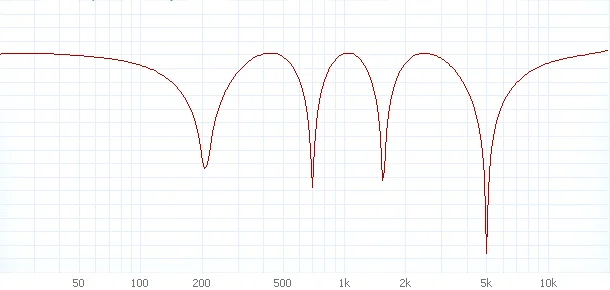
What is a signal’s phase
Phase is a term used broadly used, and that many times leads to confusion. Phase is the position of a point in time on a waveform cycle, and it’s used to compare different waveform signals between them. It’s nothing to be afraid about! Just imagine a simple sound wave like the following one. If we say the signal’s phase is 0º, we would be considering the signal from the first point. If we said it has 90º, from the second one and so on. After 360º, the signal just repeats itself so to make it easier, each 360º we start counting from 0º again.
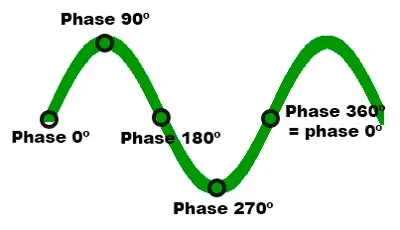
Here are some examples. To make it easier, we’ll speak of “mountains” (maximums of the signal) and “valleys” (minimums of the signal). Green and blue are the two signals, and red is the addition of the two:
a) These two signals are in phase: they start all from the same point. When we add them, the valleys add with the valleys and the mountains with the mountains, so we have an output signal with mountains and valleys.
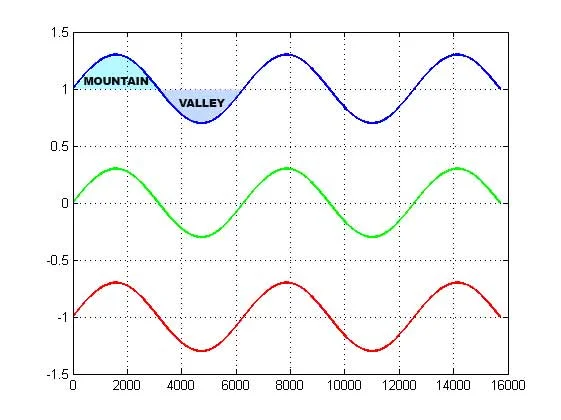
b) These two signals are 180º out of phase or inverted: they are totally inverted and, when we add them, the valley of the blue signal will cancel with the mountain of the green one and vice-versa, and the output signal will be zero.
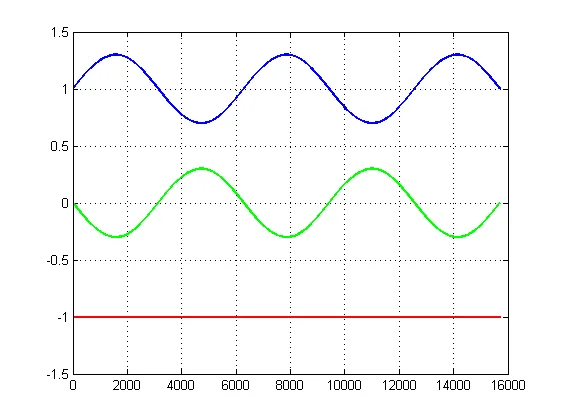
c) These two signals are slightly out of phase, and when they are added the output will be in between the maximum and the minimum.
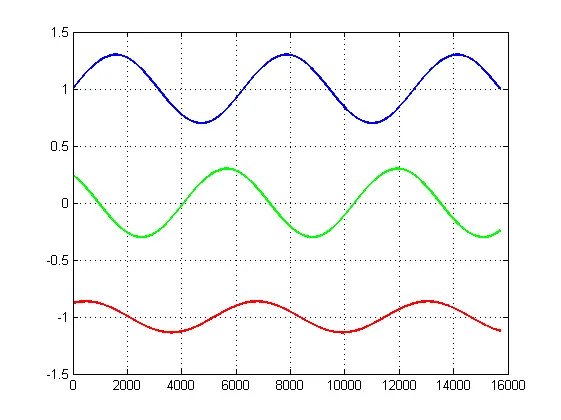
How phase is achieved
For this analysis, we’ll start from the base that an audio signal, which has multiple frequencies into 20Hz~20kHz, can be splitted into multiple sine waves that represent each one of these frequencies. To get the phase effect from a dry signal, we initially split it into two identical signals. Each of them will travel through a different path and only one of them will be modified. After that, both will be recombined into the output signal, that will be different from the original one:
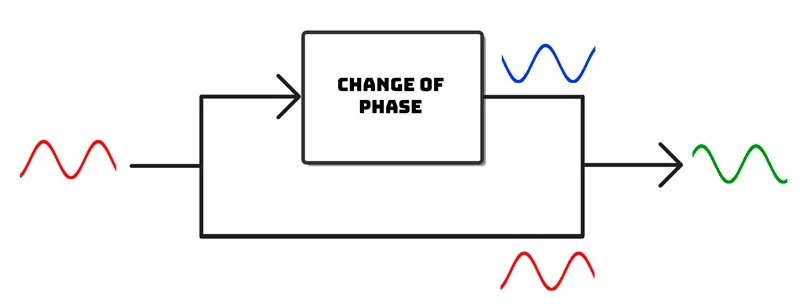
This modification of the signal is a change of phase (that’s why they’re called phasers!), that translates into a slight delay for one of the signals. Depending on how much the signal is delayed, we will have a different relative change of phase, and we will have three cases as we’ve explained in the previous section. Remember that this is just for one sine wave (that means, one frequency), and that split-delay-addition process happens for every frequency of the signal (and for each one we can have one of the following cases).
- If the signals are 360º out of phase, then the signals are in phase and the resulting output signal (and the corresponding frequency) will have no change in the volume.
- If the signals are 180º out of phase, the signals are inverted and the resulting output signal (and the corresponding frequency) will be cancelled, which leads to 0 volume.
- In any other case, the output signal will be in between the maximum and the minimum, which leads to a volume in between the original and the minimum.

For these explanation we’ve considered a simple sine wave, but the same approach happens for each one of the sine waves that form the audio signal. That means that, for example, maybe the 1kHz, 2kHz and 4kHz frequencies are enhanced while 700Hz, 1.4kHz and 2.8kHz are cancelled: it can be seen, as we’ve explained in the beginning, as an equalizer with multiple bands. Even if it turns into a change of volume, the phaser only creates a change of phase in the signal. It does not process them in any way or modify their volume. Also, in a real effect, these peaks won’t be static as we will have an oscillator that will make them change. Ever wondered what your phaser “Speed” potentiometer is controlling? Exactly: your internal oscillator oscillation frequency.
How does a phaser sound
Lastly, we’ve generated some phase sounds using the split-delay-addition algorithm. The first signal is the dry sound, the second one the sound through a 0.5Hz phaser and the third the sound through a 6Hz phaser.

